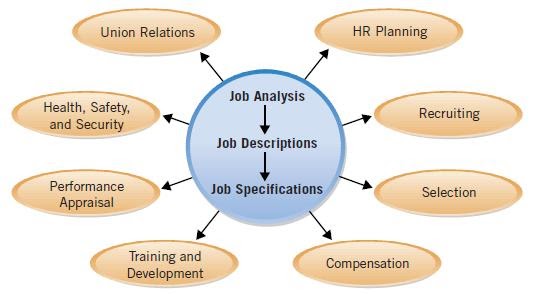The completion of job descriptions and job specifications, based on job analysis, is at the heart of many other HR activities, as Figure indicates. But even if legal requirements did not force employers to do job analysis, effective HR management would demand it.
HR Planning
HR planning requires auditing of current jobs. Current job descriptions provide the basic details necessary for this internal assessment, including such items as the jobs available, current number of jobs and positions, and reporting relationships of the jobs. By identifying the functions currently being performed and calculating the time being spent to perform them, managers and HR specialists can redesign jobs to eliminate unnecessary tasks and combine responsibilities where desirable.
When reviewing the information provided by both employees and supervisors, a team composed of the HR Manager, the Director of Administration, and an outside consultant noted that several duties associated with maintaining customer service records were divided among three employees. This often led to delays in recording customer payments and scheduling repair services. The team regrouped the various customer service duties so that two of the employees perform but different functions. Filing activities were concentrated with the third employee, who also served as backup for the other two.
Recruiting and Selection
Equal employment opportunity guidelines clearly require a sound and comprehensive job analysis to validate recruiting and selection criteria. Without a systematic investigation of a job, an employer may be using requirements that are not specifically job related.
For example, if a medical clinic requires a high school diploma for a medical records clerk job, the firm must be able to justify how such an educational requirement matches up to the tasks, duties, and responsibilities of that job. It must be able to show that the knowledge, skills, and abilities needed by the medical records clerk could be obtained only through formal education.

Organizations use job analysis to identify job specifications in order to plan how and where to obtain employees for anticipated job openings, whether recruited internally or externally. For example, a job analysis for a small manufacturer of electric equipment showed that the Accountant II job, which traditionally had required a college-trained person, really could be handled by someone with high school training in bookkeeping and several years of experience. As a result, the company could select from within and promote a current accounting clerk. In addition to saving on recruiting costs, promotion can have a positive impact on employee commitment and career-planning efforts.
Compensation
Job analysis information is essential when determining compensation. As part of identifying appropriate compensation, job analysis information is used to determine job content for internal comparisons of responsibilities and external comparisons with the compensation paid by competing employers. Information from job analysis can be used to give more weight, and therefore more pay, to jobs involving more difficult tasks, duties, and responsibilities. Employees’ perceptions of fairness and equity are linked not only to how the extrinsic rewards they receive compare with those given to others both inside and outside the organization but also to those rewards they expect for themselves. Job analysis also can aid in the management of various employee benefits programs. For instance, a job analysis can be used to determine what functions can be performed by workers who have been on workers’ compensation disability leave.
Training and Development
By defining what activities comprise a job, a job analysis helps the supervisor explain that job to a new employee. Information from job descriptions and job specifications can also help in career planning by showing employees what is expected in jobs that they may choose in the future. Job specification information can point out areas in which employees might need to develop in order to further their careers. Employee development efforts by organizations depend on the job descriptions and job specifications generated from job analyses.
Performance Appraisal
With performance standards to compare what an employee is supposed to be doing with what the person actually has done, a supervisor can determine the employee’s performance level. The performance appraisal process should then tie to the job description and performance standards. Developing clear, realistic performance standards can also reduce communication problems in performance appraisal feedback among managers, supervisors, and employees.
Safety and Health
Job analysis information is useful in identifying possible job hazards and working conditions associated with jobs. From the information gathered, managers and HR specialists can work together to identify the health and safety equipment needed, specify work methods, and train workers.
Union Relations
Where workers are represented by a labor union, job analysis is used in several ways. First, job analysis information may be needed to determine if the job should be covered by the union agreements. Specifically, management may be able to exclude a supervisory job and its incumbents from the bargaining unit. Second, it is common in unionized environments for job descriptions to be very specific about what tasks are and are not covered in a job. Finally, well-written and specific job descriptions can reduce the number of grievances filed by workers.
In one manufacturing plant, a worker refused to sweep up his work area and was disciplined. He filed a grievance and won, because cleaning his work area was not mentioned in the job description.





